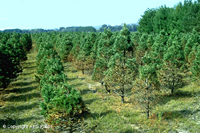Marie A. C. Langham,
South Dakota State University
Christmas is coming soon with its celebration and good cheer. There are many traditions and customs that form part of this season. One of these is the custom of kissing under a sprig of mistletoe hung from a doorway or ceiling. This custom has been a part of the season for hundreds of years, but what is mistletoe and how did it become a part of the Christmas season?
Mistletoe is a parasitic seed plant. This means that it is a plant that derives part or all of its nutrition by parasitizing another plant. In the case of leafy mistletoe (Phoradendron; Viscum album) that we are familiar with from Christmas, it derives only water and minerals from the host plant (hemiparsite). Leafy mistletoe has chlorophyll and can produce its own carbohydrates through photosynthesis. It also produces white berries with a single seed in each. Other parasitic seed plants that do not have chlorophyll, such as dwarf mistletoe (Arceuthobium) or dodder (Cuscuta), derive all of their nutrition, water, minerals, and carbohydrates from the host plant (holoparasite).
Mistletoe is transmitted from tree to tree by birds feeding on the berries. The white berries mature in the early winter and are eaten by birds. When birds carry them to an uninfected tree, the seed adheres to a new tree by the sticky viscous fluid surrounding it. As the seed germinates, it sends a radicle (a root-like growth) along the branch surface. When the radicle detects an irregularity in the bark, it produces a swelling called a holdfast. The mistletoe then produces a substance to cement the holdfast to the bark. A wedge-shaped penetration peg is produced to break through the bark and into the cortex. Once connected with the host’s cortex and vascular tissue, the mistletoe produces connections called “sinkers” that absorb the water and nutrients. Heavy infestations of mistletoe can cause a nutritional depletion for the host, but single or small infestations will not cause a significant loss of nutrients. Mistletoe causes spindle-shaped swellings on the host and may also cause a proliferation of small branches called witches’ broom.
Mistletoes are perennials and retain their green chlorophyll year round. They are most easily observed after their host tree has lost its leaves in the fall. Early civilizations believed that this meant that the mistletoe held the life of the host tree while it was dormant. This belief caused mistletoe to be considered a source of mystical power that could be channeled into healing powers. Druids in ancient Gaul, Britain, and Ireland harvested mistletoe with a golden sickle for their Solstice celebrations. In Norse legends, a connection to mistletoe is found with the Norse god, Balder. In order to protect him from harm, his father, Odin, and his mother, Frigga, asked the elements and all living beings never to harm Balder. However, they forgot to ask the mistletoe. Loki, a rival of Balder made an arrow of mistletoe and gave it to Balder’s blind brother, Hoder, to shoot. Loki promised to help Hoder aim the arrow, but he aimed at Balder instead of the target. Thus, Balder was killed. After the elements tried to restore his life and failed, Balder was restored to life by his mother, whose tears turned into the pearly white berries on the mistletoe. Frigga, rejoicing for her son’s return, forgave the mistletoe and gave it a blessing (in the form of a kiss) for everyone who stands under it. Thus, hanging mistletoe became a symbol of blessings and good fortune for celebrations. As Christianity spread across ancient Europe, these customs were incorporated into Christmas celebrations. So, enjoy hanging mistletoe this Christmas, but be sure to hang it securely for mistletoe is said to lose its mystical powers if it drops to the ground.
For more information on mistletoe, try the following sources:
 |
Views: Plant pathogens can affect many traditional Christmas decorations such as these Christmas trees that are infected by Lecanosticta needle blight (caused by the fungus Mycosphaerella dearnessii) on Scot's pine Christmas trees. Click image for an enlarged view and more information.
|
